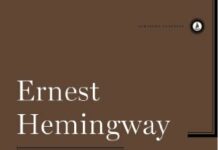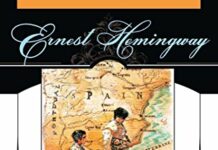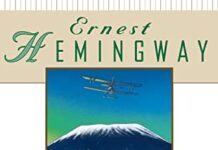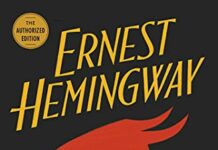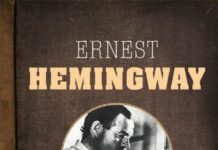
Ebook Info
- Published: 1998
- Number of pages: 650 pages
- Format: EPUB
- File Size: 0.77 MB
- Authors: Ernest Hemingway
Description
The complete, authoritative collection of Ernest Hemingway’s short fiction, including classic stories like “The Snows of Kilimanjaro,” “A Clean, Well-Lighted Place,” and “The Short Happy Life of Francis Macomber,” along with seven previously unpublished stories.In this definitive collection of the Nobel Prize-winning author’s short stories, readers will delight in Hemingway’s most beloved classics such as “The Snows of Kilimanjaro,” “Hills Like White Elephants,” and “A Clean, Well-Lighted Place,” and will discover seven new tales published for the first time in this collection, totaling in sixty stories. This collection demonstrates Hemingway’s ability to write beautiful prose for each distinct story, with plots that range from experiences of World War II to beautifully touching moments between a father and son. For Hemingway fans, The Complete Short Stories is an invaluable treasury.
User’s Reviews
Editorial Reviews: About the Author Ernest Hemingway did more to change the style of English prose than any other writer of his time. Publication of The Sun Also Rises and A Farewell to Arms immediately established Hemingway as one of the greatest literary lights of the twentieth century. His classic novel The Old Man and the Sea won the Pulitzer Prize in 1953. Hemingway was awarded the Nobel Prize for Literature in 1954. His life and accomplishments are explored in-depth in the PBS documentary film from Ken Burns and Lynn Novick, Hemingway. Known for his larger-than-life personality and his passions for bullfighting, fishing, and big-game hunting, he died in Ketchum, Idaho on July 2, 1961. Excerpt. © Reprinted by permission. All rights reserved. The Complete Short Stories Of Ernest HemingwayThe Finca Vigia EditionBy Ernest HemingwayScribnerCopyright ©1998 Ernest HemingwayAll right reserved.ISBN: 0684843323Publisher’s PrefaceThere has long been a need for a complete and up-to-date edition of the shortstories of Ernest Hemingway. Until now the only such volume was the omnibuscollection of the first forty-nine stories published in 1938 together withHemingway’s play The Fifth Column. That was a fertile period ofHemingway’s writing and a number of stories based on his experiences in Cubaand Spain were appearing in magazines, but too late to have been included in”The First Forty-nine.”In 1939 Hemingway was already considering a new collection of stories thatwould take its place beside the earlier books In Our Time, Men WithoutWomen, and Winner Take Nothing. On February 7 he wrote from his homein Key West to his editor Maxwell Perkins at Scribners suggesting such a book.At that time he had already completed five stories: “The Denunciation,” “TheButterfly and the Tank,” “Night Before Battle,” “Nobody Ever Dies,” and”Landscape with Figures,” which is published here for the first time. A sixthstory, “Under the Ridge,” would appear shortly in the March 1939 edition ofCosmopolitan.As it turned out, Hemingway’s plans for that new book did not pan out. He hadcommitted himself to writing three “very long” stories to round out thecollection (two dealing with battles in the Spanish Civil War and one about theCuban fisherman who fought a swordfish for four days and four nights only tolose it to sharks). But once Hemingway got underway on his novel — later published as For Whom the Bell Tolls — all other writing projects werelaid aside. We can only speculate on the two war stories he abandoned, but itis probable that much of what they might have included found its way into thenovel. As for the story of the Cuban fisherman, he did eventually return to itthirteen years later when he developed and transformed it into his famousnovella, The Old Man and the Sea.Many of Hemingway’s early stories are set in northern Michigan, where hisfamily owned a cottage on Waloon Lake and where he spent his summers as a boyand youth. The group of friends he made there, including the Indians who livednearby, are doubtless represented in various stories, and some of the episodesare probably based at least partly on fact. Hemingway’s aim was to conveyvividly and exactly moments of exquisite importance and poignancy, experiencesthat might appropriately be described as “epiphanies.” The posthumouslypublished “Summer People” and the fragment called “The Last Good Country” stemfrom this period.Later stories, also set in America, relate to Hemingway’s experiences as ahusband and father, and even as a hospital patient. The cast of characters andthe variety of themes became as diversified as the author’s own life. Onespecial source of material was his life in Key West, where he lived in thetwenties and thirties. His encounters with the sea on his fishing boatPilar, taken together with his circle of friends, were the inspirationof some of his best writing. The two Harry Morgan stories, “One Trip Across” (Cosmopolitan, 1934) and “The Tradesman’s Return” (Esquire, February 1936), which draw from this period, were ultimately incorporated into the novel To Have and Have Not, but it is appropriate and enjoyable to read them as separate stories, as they first appeared. Hemingway must have been one of the most perceptive travelers in the history of literature, and his stories taken as a whole present a world of experience. In 1918 he signed up for ambulance duty in Italy as a member of an American Field Service unit. It was his first transatlantic journey and he was eighteen at the time. On the day of his arrival in Milan a munitions factory blew up, and with the other volunteers in his contingent Hemingway was assigned to gather up the remains of the dead. Only three months later he was badly wounded in both legsand hospitalized in the American Red Cross hospital in Milan, with subsequentoutpatient treatment. These wartime experiences, including the people he met,provided many details for his novel of World War I, A Farewell to Arms.They also inspired five short story masterpieces.In the 1920s he revisited Italy several times; sometimes as a professionaljournalist and sometimes for pleasure. His short story about a motor trip witha friend through Mussolini’s Italy, “Che Ti Dice La Patria?,” succeeds inconveying the harsh atmosphere of a totalitarian regime.Between 1922 and 1924 Hemingway made several trips to Switzerland to gathermaterial for The Toronto Star. His subjects included economic conditionsand other practical subjects, but also accounts of Swiss winter sports:bobsledding, skiing, and the hazardous luge. As in other fields, Hemingway wasahead of his compatriots in discovering places and pleasures that would becometourist attractions. At the same time, he was storing up ideas for a number ofhis short stories, with themes ranging from the comic to the serious and themacabre.Hemingway attended his first bullfight, in the company of American friends, in1923, when he made an excursion to Madrid from Paris, where he was living atthe time. From the moment the first bull burst into the ring he was overwhelmedby the experience and left the scene a lifelong fan. For him the spectacle of aman pitted against a wild bull was a tragedy rather than a sport. He wasfascinated by its techniques and conventions, the skill and courage required bythe toreros, and the sheer violence of the bulls. He soon became anacknowledged expert on bullfighting and wrote a famous treatise on the subject,Death in the Afternoon. A number of his stories also have bullfightingthemes.In time, Hemingway came to love all of Spain — its customs, its landscapes,its art treasures, and its people. When the Spanish Civil War broke out in thelast week of July 1936, he was a staunch supporter of the Loyalists, helping toprovide support for their cause and covering the war from Madrid as acorrespondent for the North American Newspaper Alliance. Out of the entirety ofhis experiences in Spain during the war he produced seven short stories inaddition to his novel, For Whom the Bell Tolls, and his play, TheFifth Column. It was one of the most prolific and inspired periods of hiswriting career.In 1933, when his wife Pauline’s wealthy uncle Gus Pfeiffer offered to stakethe Hemingways to an African safari, Ernest was totally captivated by theprospect and made endless preparations, including inviting a company of friendsto join them and selecting suitable weapons and other equipment for the trip.The safari itself lasted about ten weeks, but everything he saw seems to havemade an indelible impression on his mind. Perhaps he regained, as the result ofhis enthusiasm and interest, a childlike capacity to record details almostphotographically. It was his first meeting with the famous white hunter PhillipPercival, whom he admired at once for his cool and sometimes cunningprofessionalism. At the end of the safari, Hemingway had filled his mind withimages, incidents, and character studies of unique value for his writings. Asthe harvest of the trip he wrote the nonfiction novel Green Hills ofAfrica, and some of his finest stories. These include “The Short Happy Lifeof Francis Macomber” and “The Snows of Kilimanjaro” as well as “An AfricanStory,” which appeared as a story within a story in The Garden of Eden,a novel published posthumously in May 1986.In spite of the obvious importance of the Paris years on Hemingway’sdevelopment as a writer, few of his short stories have French settings. He wasaware of that fact and in his preface to A Moveable Feast wistfullymentions subjects that he might have written about, some of which might havebecome short stories.During World War II Hemingway served as a war correspondent covering theNormandy invasions and the liberation of Paris. It seems that he also assembled a group of extramilitary scouts keeping pace with the retreating Germans. The balance between fiction and nonfiction in his stories of the period, including the previously unpublished “Black Ass at the Cross Roads,” may never be determined.Toward the end of his life Hemingway wrote two fables for the child of afriend, “The Good Lion” and “The Faithful Bull,” which were published byHoliday in 1951 and are reprinted here. He also published two shortstories in The Atlantic Monthly, “Get a Seeing-Eyed Dog,” and “A Man of the World” (both December 20, 1957).We have grouped seven previously unpublished works of fiction at the back ofthe book. Four of these represent completed short stories; the other threecomprise extended scenes from unpublished, uncompleted novels.All in all, this Finca Vigía edition contains twenty-one stories that were not included in “The First Forty-nine.” The collection is named for Hemingway’s home in San Francisco de Paula, Cuba. He lived at Finca Vigía (“Lookout Farm”) on and off during the last two decades of his life. The finca was dear to his heart and it seems appropriate now that it should contain a major portion of his life work, which was even more dear.– Charles Scribner, Jr. Copyright © 1987 by Simon & Schuster Inc.ForewordWhen Papa and Marty first rented in 1940 the Finca Vigía which was to be his home for the next twenty-two years until his death, there was still a real country on the south side. This country no longer exists. It was not done in by middle-class real estate developers like Chekhov’s cherry orchard, which might have been its fate in Puerto Rico or Cuba without the Castro revolution, but by the startling growth of the population of poor people and their shack housing which is such a feature of all the Greater Antilles, no matter what their political persuasion.As children in the very early morning lying awake in bed in our own little house that Marty had fixed up for us, we used to listen for the whistling call of the bobwhites in that country to the south.It was a country covered in manigua thicket and in the tall flamboyante trees that grew along the watercourse that ran through it, wild guinea fowl used to come and roost in the evening. They would be calling to each other, keeping in touch with each other in the thicket, as they walked and scratched and with little bursts of running moved back toward their roosting trees at the end of their day’s foraging in the thicket.Manigua thicket is a scrub acacia thornbush from Africa, the first seeds of which the Creoles say came to the island between the toes of the black slaves. The guinea fowl were from Africa too. They never really became as tame as the other barnyard fowl the Spanish settlers brought with them and some escaped and throve in the monsoon tropical climate, just as Papa told us some of the black slaves had escaped from the shipwreck of slave ships on the coast of South America, enough of them together with their culture and language intact so that they were able to live together in the wilderness down to the present day just as they had lived in Africa.Vigía in Spanish means a lookout or a prospect. The farmhouse is built on a hill that commands an unobstructed view of Havana and the coastal plain to the north. There is nothing African or even continental about this view to the north. It is a Creole island view of the sort made familiar by the tropical watercolors of Winslow Homer, with royal palms, blue sky, and the small, white cumulus clouds that continuously change in shape and size at the top of the shallow northeast trade wind, the brisa.In the late summer, when the doldrums, following the sun, move north, there are often, as the heat builds in the afternoons, spectacular thunderstorms that relieve for a while the humid heat, chubascos that form inland to the south and move northward out to the sea.In some summers, a hurricane or two would cut swaths through the shack houses of the poor on the island. Hurricane victims, damnificados del ciclón, would then add a new tension to local politics, already taut enough under the strain of insufficient municipal water supplies, perceived outrages to national honor like the luridly reported urination on the monument to José Martí by drunken American servicemen and, always, the price of sugar.Lightning must still strike the house many times each summer, and when we were children there no one would use the telephone during a thunderstorm after the time Papa was hurled to the floor in the middle of a call, himself and the whole room glowing in the blue light of Saint Elmo’s fire.During the early years at the finca, Papa did not appear to write any fiction at all. He wrote many letters, of course, and in one of them he says that it is his turn to rest. Let the world get on with the mess it had gotten itself into.Marty was the one who seemed to write and to have kept her taste for the high excitement of their life together in Madrid during the last period of the Spanish Civil War. Papa and she played a lot of tennis with each other on the clay court down by the swimming pool and there were often tennis parties with their friends among the Basque professional jai alai players from the fronton in Havana. One of these was what the young girls today would call a hunk, and Marty flirted with him a little and Papa spoke of his rival, whom he would now and again beat at tennis by the lowest form of cunning expressed in spins and chops and lobs against the towering but uncontrolled honest strength of the rival.It was all great fun for us, the deep-sea fishing on the Pilar that Gregorio Fuentes, the mate, kept always ready for use in the little fishing harbor of Cojimar, the live pigeon shooting at the Club de Cazadores del Cerro, the trips into Havana for drinks at the Floridita and to buy The Illustrated London News with its detailed drawings of the war so far away in Europe.Papa, who was always very good at that sort of thing, suggested a quotation from Turgenev to Marty: “The heart of another is a dark forest,” and she used part of it for the title of a work of fiction she had just completed at the time.Although the Finca Vigía collection contains all the stories that appearedin the first comprehensive collection of Papa’s short stories published in 1938, those stories are now well known. Much of this collection’s interest to the reader will no doubt be in the stories that were written or only came to light after he came to live at the Finca Vigía.– JOHN, PATRICK, AND GREGORY HEMINGWAY1987Copyright © 1987 by Simon & Schuster Inc.Continues…Excerpted from The Complete Short Stories Of Ernest Hemingwayby Ernest Hemingway Copyright ©1998 by Ernest Hemingway. Excerpted by permission. All rights reserved. No part of this excerpt may be reproduced or reprinted without permission in writing from the publisher.Excerpts are provided by Dial-A-Book Inc. solely for the personal use of visitors to this web site.
Reviews from Amazon users which were colected at the time this book was published on the website:
⭐This book collects all of Hemingway’s stories, which are terrific. I prefer his earlier stories, particularly Indian Camp, Up in Michigan, Fifty Grand, and the Killers. But the more recent stories are good too, with the exception of a few mean spirited ones.Regarding Hemingway’s treatment of women, there are sympathetic and strong female characters here, in the setting of a very different social milieu. I do think Hemingway has the ability to write about both genders.A number of stories center on the issue of physical and moral courage, which Hemingway tends to equate with traditional notions of masculine roles. In a few stories (The Short Happy life of Francis McCumber) the female tends to be a male trophy. But by and large, I think Hemingway’s writing on physical courage does translate to the modern day, and his code hero of grace under pressure does not exclude women.More concerning is the nasty strain of racism in a few of these stories. Yes, Hemingway wants to capture what characters thought and said 100 years ago — which inevitably included pejorative characterizations of African Americans. But sometimes the use of the N word is entirely gratuitous. In one story, Nick Adams happens upon a punch drunk fighter and his black companion. The narrator for no good reason describes the black man’s “N— legs.” This particular character is probably the most sympathetic of the black characters. Almost all of the blacks are portrayed as servile and cowardly.Still, Hemingway must be read. His powerful use of simple, direct language and his “iceberg theory” really revolutionized the short story
⭐The core of this three-part collection is “The First Forty-nine”, a compilation of stories that Hemingway selected and published in 1938. While the first four stories in Part I–including the famous `The Short Happy Life of Francis Macomber’ and `The Snows of Kilimanjaro’–were new to this collection, Hemingway cherry-picked the remaining 45 stories in Part I from “Three Stories and Ten Poems” (1923), “In Our Time” (1925 and 1930), “Men Without Women” (1927), and “Winner Take Nothing” (1933). Meanwhile, Part II has 14 stories that Hem published in books and magazines subsequent to “The First Forty-nine”. Finally, Part III contains six stories unpublished in Hem’s lifetime and that first appeared in this Finca Vigia Edition.There are some tremendous stories in this collection. My favorites are `The Undefeated’ (from MWW), `A Way You’ll Never Be’ (from WTN), and `One Trip Across’ (incorporated into “To Have and To Have Not”). These are stories everyone should read. I particularly liked `One Trip Across’ where Hem, in the first-person, writes a great fishing and crime story while working with his characteristic themes of grace under pressure, honor, and sudden death. Here’s a snippet, with Harry Morgan drifting in Havana’s harbor:”Well, I killed the engine and climbed up forward to have a look around. All there was to see was the two smacks off to the westward headed in, and way back the dome of the Capitol standing up white out of the edge of the sea. There was some gulfweed on the stream and a few birds working but not many. I sat up there awhile on top of the house and watched…”In the spirit of full disclosure, I acknowledge reading less than half of the 69 stories in this collection. This I attribute to the best-selling Hem who, in 1938, certainly wanted another book out there. And in cherry-picking previously published stories, he created a collection that, while reflective of his themes, jumps from this to that. Of course, the man made a good living, partly by publishing short stories in magazines, where he certainly endeavored to keep his readers guessing about what he would do next. Even so, I bet the stories read with greater cohesion in the original books. This approach, at minimum, might give greater oomph to the inter-chapter sketches that Hem borrowed from “In Our Time”. In this collection, these seem random and fragmented.Following this line of thought, it might also be fun to read “The Nick Adams Stories”. While this is a posthumous and fabricated volume, it does enable the reader to follow an interesting character from a heartland upbringing, to war and trauma, and to his own experience of fatherhood. Otherwise, these stories are scattered.Don’t get me wrong; this is a worthwhile collection. But doesn’t it compromise the guy’s work?
⭐His stories are enthralling as well as heartbreaking
⭐Some say that the notorious reputation of Ernest Hemingway is eclipsed by the brilliant content of his books. Well, if that’s the case then I don’t see it here.Before reading this book I was expecting it to be different from the author’s mischievous traits. But these short stories only confirm that the writing matches the character of the writer, the self-loathing, misogynistic, egocentric, alcoholic bully, with a hint of racism, that sees life from a cynical point of view.But I kinda like that edginess about him, he’s like the dark chaotic mess that some people grew to love from a character, like Raymond Reddington or the Joker. It also serves a purpose for the bigger picture, as we can’t appreciate the hopeful optimistic ones if we can’t see the contrasting bleak views.However, there’s only so much N words that I can handle before I felt enough was enough (at about the 54% mark). But I kept skim reading it though, in a writing flow that continues to be dry and unengaging, with stories short enough that I never get a chance to be emotionally invested in any of them. It’s safe to say that my reading experience really doesn’t match up with all the hype about Hemingway.So naturally it got me thinking, is this it? Is this really a book written by that legendary writer? Like an abused child still seeking for love and approval, I began to think that maybe these 70 short stories are not the best introduction that reflects the real Hemingway, that the problem is not the book but my inexperience when it comes to reading fiction books.So perhaps I need to read at least one of his masterpieces before I can judge any further. Because afterall, for every hater there’s a genuine lover of his literary prowess, so there must be something that I’m still missing.Never in my life that my response to a mediocre book is to put another book by the same author in my reading list. But I guess that’s exactly what I’m going to do.
⭐This is perhaps one of the hardest reviews I’ve had to write, mainly because I don’t feel qualified to critique an author of Ernest Hemingway’s calibre. It is tempting just to write that I enjoyed some of the stories more than others. But that’s not really helpful because one can write that about any collection of short stories. Instead I shall pick out four stories that have stayed in my mind long after I have finished them.The first is ‘The Short, Happy Life of Francis Macomber’ – which is also the first story in this compilation. At one level this is a story about big game hunting in Africa. I won’t give away any more than that in case it spoils the story for anyone who hasn’t read it. At another level, it explores death, fear, sexual fidelity, machismo and probably a few other aspects of the human condition that are less obvious. The meaning of the story is still debated today and there is disagreement about what exactly was happening inside the heads of the three main protagonists. In one sense, the story has a clear beginning, middle and end, and is neatly finished. But of course, it isn’t neatly finished and that is where the fascination lies.The next story is ‘The Undefeated’ about a courageous but stupid matador facing an equally courageous but stupid bull. It is not clear whether the title refers to the matador, the bull or both. Whilst it is clear that this story is inspired by Hemingway’s fascination with bull-fighting, it is more an analysis of the recklessness shown by those who have nothing to lose. The story might equally well have been about a gambler upping the ante to win back his money, or an alcoholic drinking to prove his victory over the bottle.Third is ‘The Last Good Country’ which is an account of a young man fleeing from the law with his younger sister. It is an account of survival in the wild, and it carries strong suggestions of incest. The female character is in love with her brother, but he appears to be less certain of his feelings although he clearly is not indifferent. This is an unfinished story – although many readers, including myself, find it as complete as is necessary to make it a satisfying short story. Regardless of whether or not it is unfinished, it is a fascinating read. It has been suggested this story is the beginning of a novella or novel and that Hemingway got bored with it, or couldn’t work out how to take it forward. We shall never know. But I think it’s fine just the way it is.And finally ‘The Killers’. This story was published in 1927 when Hemingway was only twenty-eight. It is about two hit men who enter a bar to kill a boxer who failed to ‘throw’ a fight. It is a tale of brutality, corruption, courage and one man’s indifference to death (or three men’s indifference if you include the two killers who know nothing about their intended victim apart from his identity). One of the most striking things about this story – apart from the understated quality of the narrative – is the fact that it is almost entirely carried by dialogue. We ‘see’ what happens because we ‘hear’ what happens. Whilst other writers have copied this technique, it was innovative at the time. This is a story that repays several readings in order to get the full flavour and all the nuances.To be blunt, some of the other stories in this compilation probably shouldn’t be there. They seem to be scraps written down by Hemingway for his notebook as the basis for longer stories that never got written. Some are barely one page long. It’s possible I’ve missed something in them, in which case I apologise to Hemingway’s ghost. But 90% of the stories are first class, original and entertaining and excellent models for anyone aspiring to write short stories.Overall, this is a terrific collection of tales by one of the great writers of the 20th Century. Strongly recommended.
⭐Ernest Hemingway is still recognised as a powerhouse in American literature, although to claim that everything he wrote was brilliant would be an overstatement because he did produce a few middling novels amongst his gems. On the subject of his short stories though I have always found a rather better quantity of quality, with even the poorer ones in this book still being highly readable. And if you think about it, arguably his very best book is the novella The Old Man and the Sea, which shows his craftsmanship at its very finest, in something that really is quite flawless.Starting off with writing short stories then, this was where Hemingway learnt to pair down his writing to its essentials and develop his style which has been so influential ever since, inspiring many others, and altering the development of literature in America to a certain degree. This Finca Vigía edition then has three parts, the first being the original stories that were published in a collection called The First Forty-Nine, the second part are stories that were published subsequent to that book, and finally the third part is unpublished fiction, some of which are short stories, and a few that were originally meant to be the early chapters of books that were subsequently altered. We thus have a cornucopia of tales with something that should suit everyone, and in some you meet the same characters again, such as Nick Adams.Taking in war, hunting, both at home in America as well as big game in Africa, we also have fishing and other themes. Some of these stories are real gems in the world of short stories, with others although not quite coming up to the mark of absolute mastery and genius still being very good. Taking in such underlying themes as love, loss and loneliness, there is also feeling at times emasculated, relationships, and death, along with others, giving us a broad aspect of life in general.Using his own life and experiences as well as others that he had witnessed, so Hemingway always built up a believable situation and at times skilfully subverted what we would expect to happen, but we do have to chuckle at times with the way some of his characters, who are drunkards are treated, with the great irony of course being the author’s own overuse of alcohol. One thing that you do notice here is that a couple of tales include bedroom scenes, and we can see how badly Hemingway was at writing these. In all though, this is still a great collection to read, and is sure to go down well with those who have not read these before, and it is also an ideal introduction into all the works of Hemingway.
⭐Hemingway is /was brilliant. But not all the time. Far too many of these short stories came across as vignettes – almost as if he had to hit a deadline for a daily column and had run out of inspiration so relied on so what did I observe today? I know he took journalistic licence with his military ‘memories’ – embellished the heroics to make for much better copy – but even he tired of doing that eventually. Me? I’ll get through a book if it kills me – but the suffering was too prolonged. Some of the stories – real genius. Others , space and time fillers.
⭐I bought this book for my husband who is a big fan of Hemmingways short stories.The print is rather on the small side but still readable. Luckily he will be dipping in and out of the book so it won’t matter too much.
⭐I am enjoying reading these unforgettable stories. Anyone who likes the genre will appreciate the economy of words when describing complex events and emotions. Great stories of love and courage, challenges and rewards and set in unforgettably described places and times. The characters are always interesting and spring to life with grace and ease and leave indelible images. As unique as Guy Maupassant and as readable and captivating as Raymond Carver.Roy
Keywords
Free Download The Complete Short Stories of Ernest Hemingway in EPUB format
The Complete Short Stories of Ernest Hemingway EPUB Free Download
Download The Complete Short Stories of Ernest Hemingway 1998 EPUB Free
The Complete Short Stories of Ernest Hemingway 1998 EPUB Free Download
Download The Complete Short Stories of Ernest Hemingway EPUB
Free Download Ebook The Complete Short Stories of Ernest Hemingway
